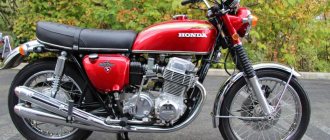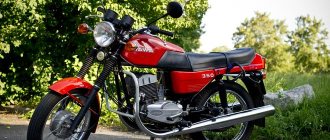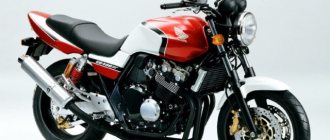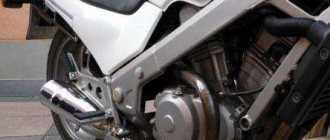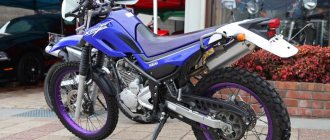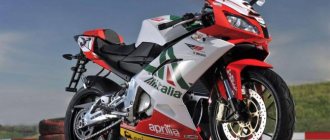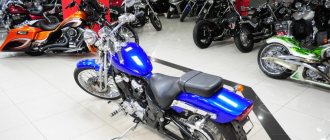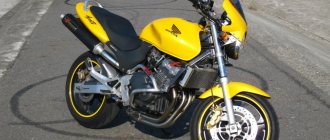RU-MOTO rating
- Reliability
- Chassis
- Appearance
- Comfort
4.3
Verdict
This motorcycle was the dream of every motorcycle enthusiast in the USSR. Reliability, beauty, speed are the key words of this motorcycle. It gained its main popularity in the 80s and 90s of the last century.
In 1929, Frantisek Janicek acquired equipment and a license for the production of motorcycles from. From the abbreviated name of the owner and the name of the company, the name of the new brand “Java” appeared.
Model history
The first model of this brand had a four-stroke engine with a capacity of 500 cm3. The motorcycle was not a success as it was heavy, unreliable and difficult to repair. The company found its element in two-stroke engines. Which were produced both single-cylinder and two-cylinder.
The company gained real momentum in the post-war years. The main exporter of popular motorcycles was the Soviet Union. Every third Soviet motorcyclist was the proud owner of a Java. The first Java 350/638 models appeared in the 80s of the last century.
How to convert a motorcycle in Java (JAVA). We install another engine
I am a convinced "Yavist".
I had almost all the post-war models of Yavs and Chesetovs. There was also a cross-country CheZet-250. But my favorite model is Java-250. But I want to tell you about a motorcycle that I made myself. The idea to install a motor from a foreign car in Java arose spontaneously when I saw on the market a four-stroke motor from the Cagiva enduro, with a volume of 350 cm3. The kit included: carburetor, air filter, muffler, electrical wiring, all relays and speedometer with tachometer. Consequently, there was almost no hesitation. Doubts arose when I installed the motor in the frame, because I didn’t know whether the motor would start at all, and in order for it to fit perfectly, it was necessary to cut the frame. But I didn’t want to do this, so that if something happened, I could put the original motor back. The first departure took place on December 31, 2005. We tested the motorcycle together with my friend Rostik. Our delight knew no bounds - sharp acceleration and excellent traction in any gear! The motorcycle moved easily from second and even third gear, however, the maximum speed was no more than one hundred, so I had to “conjure” with the sprockets. I settled on a ratio of 21/46. The maximum speed became 145-150 km/h (with a tailwind). Then there were many different roads... JaGiva (that’s what I called the device) turned out to be a very reliable motorcycle, if you don’t take into account minor “childhood illnesses”.
After the 2007 season, I decided to improve the design of the Java and install the motor as needed. In stock I had a front fairing from a BMW F-650 (first production) and a muffler from a BMW R-1200 GS.
First, I cut the frame, lowered the motor 3.5 cm to its rightful place, and extended the pendulum. In addition, many more details were “damaged” by the grinder. There are almost no native, Yaviv parts left. Then he took up making plastic. Oh, this is hard work, I tell you. I made the mold from polystyrene foam, then covered everything with fiberglass and epoxy glue (I had no thoughts about polyester resin). The work was carried out in winter in a cold garage, so the glue took a very long time to dry. When everything was dry, I picked out the foam. Then there was a long and grueling putty and painting. But I made it in time for Tarasova Gora 2008! After which I also visited Mirgorod, Kyiv, “Goblin Show-2008”, “Dniester Fog” in Novodnistrovka and “First Bukovina Motor Rally” in Chernivtsi. And what a fascinating trip it was to Chervonograd, in the Ternopil region!
Therefore, in June I have already traveled 4 thousand kilometers, and before winter, I think I will travel even more. I hope that my JaGiva will not let me down!
Source
Java 350/638 Lux
Java 350/638 appeared in 1985, and became a real symbol of excellence among Soviet motorcyclists. Java was head and shoulders above its Soviet counterpart, IZH Jupiter-5. And although the price was significantly higher, the motorcycle was in short supply. There were queues outside the shops to become the lucky owner of the dream.
Read other motorcycle reviews of the Honda CBR600RR: technical specifications, prices and reviews
Technical characteristics, for that time, were progressive. The two-cylinder engine produced 26 hp and was quite revvy. At that time, only IL Planet-Sport could compare with Java in dynamics, but was significantly behind in comfort. It should be mentioned that there was a “Lux” version, which had distinctive appearance features and was slightly different in the structure of the gearbox.
Shards of the past: Jawa 350 Lux review
Once upon a time, Czech motorcycles rode and looked no worse than German ones: already in the 30s, red motorcycles with the word Jawa on the chrome tank were considered one of the most modern and progressive in the world. The Second World War hit the plant hard, and the post-war world demanded other motorcycles: simple and cheap. However, simple does not mean terrible: the first two-stroke Javas differed from their competitors primarily in style and quality.
It is not surprising that, against the backdrop of everything that the Soviet industry was doing, expensive Czech foreign cars looked especially good: people dreamed about them and stood in lines just to get the coveted “Java”. The 350 evolved, but remained true to its two-stroke concept, "old lady", "stripe", "banana" - each generation received a proper name.
"Java" attracts the views of others more than any "Harley"
It was high demand that ruined the plant: while competitors from capital countries had to scratch for the buyer, look for new meanings while simultaneously responding to the challenges of the time, in the Czech Republic they did not have time to satisfy the existing demand. Why come up with something new when there’s a turn for the old? That’s why the collapse of the USSR was a real blow for the Czech plant: there was no one to sell their motorcycles.
Competitors have long mastered four-stroke engines and much larger motorcycles, and little-worn Japanese equipment has poured into the expanses of the former USSR: why do you need a stunted “Java” when for the money you can find an old Japanese “liter” that looks like it came straight out of a science fiction movie? Everyone forgot about “Java” for a good two decades, except for rare true fans.
The new headlight does not look as authentic as the old one, but the turn signals are elegant, old-fashioned
It was necessary to try all the Japanese consumer goods, set the teeth on edge with Italian and American delicacies in order to remember again about it, the motorcycle from childhood. Surprisingly, unlike dozens of other factories, Jawa remained afloat and continued to produce motorcycles, the same old ones, although with some changes. One of them, Jawa 640.143 Lux, turned out to be our test.
Video version of the review and test drive of Jawa 350 Lux:
The motorcycle is almost new, differing from the devices of the current 2018 model year only in the presence of an Oilmaster separate lubrication system and an electric starter. Yes, on new motorcycles, like on old Soviet ones, these options will not be available. Back to the Future! By the way, the motorcycle itself, which we will talk about today, appeared already in 1984, it was called Jawa 638-5-00 and was actually a transitional model between the previous generation with the index 634 and the new one, which received a different tail design and the index 638-0- 00 in 1987.
The chrome-plated exhaust raised up is a characteristic feature of all 640s
It was he who was destined to become the last mass "Java" in the post-Soviet space, and it was with him that the plant entered a crisis. It is not surprising that the next update happened already in 1995 and came down solely to replacing the expensive steel tail with cheaper plastic. But the motorcycle received a front disc brake and a new index 640, with which it has survived to this day practically unchanged.
Cornering in Java is not comfortable - thin wheels and low torsional rigidity of the chassis do not contribute to the ride on the ears
The height of the fashion for retro and nostalgia spurred Jawa to create several nostalgic models of a classic look, including the 640: in 2013, a “classic” version of this motorcycle appeared, different from the basic version, with a metal tail from the 634 model, fashionable in the early eighties last century. The motorcycle turned out to be beautiful, however, due to the too high price, it was not widely used in our market, while the regular 640 sells relatively well, although its price tag cannot be called low. So why do people pay themselves 300 thousand rubles as adults?
The cost of Java is lower than other old-timers that can be bought new today
If you have driven the 638 Java, consider that you have already read the test; there are no changes to the chassis, and the landing remains the same: vertical, with a narrow steering wheel close to the pilot and a not wide tank. The eighties as they are! And this is great, because competitors are only trying to copy the aesthetics of bygone times and hide newfangled electronics under shiny trinkets, but Jawa is not trying to look old, it is old.
A two-stroke engine on a road motorcycle today looks like an anachronism, but it’s not like everyone else’s
And even though the plastic wing with tail feathers looks cheaper than metal, the Czechs’ attempt to rejuvenate the appearance only emphasizes its real age. The same applies to the dashboard - the old-style tidy with two glasses and metal arrows looked more interesting than a monochrome monitor. But the functionality is wider - here you have a whole set of indicator lamps, a speedometer with a tape tachometer, and a watch with an odometer and two daily mileage counters. I think I even found a stopwatch in it!
The digital dashboard doesn’t look good on Java, but it’s much more convenient than analog needles
Especially such “modernities” look contrasting against the background of old remote controls, the switch bosses of which are on steel legs, and the chrome tank cap, which, it seems, has not changed since the 60s. The same applies to the old, original “Java” steering wheel handles and levers - little things that create the mood and only sharpen the tactile sensations of this time machine.
From the saddle, a classic in its purest form!
But once you start the engine... It’s not so simple: first open the fuel valve, pull out the choke, and only then press the electric starter button. By the way, the Java does not have a separate kick starter; instead, you can start the engine by first turning the gearbox pedal to the upper position. Sweet blue smoke fills the air around until it warms up - it smokes especially, remove the choke, and you're good to go! What, greenhouse kids, with their injectors, forgot how normal motorcycles start?!
And the smoke of the patronymic is sweet and pleasant to us! The characteristic blue exhaust is another feature of Java.
The main feature of the Jawa 640 is the so-called “semi-automatic”. In fact, it is an ordinary mechanics with some semblance of a quickshifter, which allows you to change gears without the participation of a rather tight clutch lever on the steering wheel in the process. In fact, it is duplicated by the gearbox pedal, which, before engaging the gear, itself depresses the clutch. It looks especially great at the moment of start, when you can move away smoothly by releasing the gearbox pedal, and not the clutch lever. Original and really convenient!
Semi-automatic clutch - the ancestor of modern quick shifters
But the engine, by today’s standards, is simply not there: 23 horsepower, which, according to rumors, can be increased to 26 simply by removing the limit washer located between the carburetor and the cylinder, is decidedly not enough for a motorcycle in the twenty-first century. The two-cylinder two-stroke engine is in no hurry to spin up and reluctantly responds to the extremely tight throttle grip, vibrations that turn into itching, a characteristic sound and smell.
The rear brake pedal is not very informative, but quite effective
If you are close to the aesthetics of engines of the past, you can’t imagine anything better, but if not, “Java” can become a real nightmare! The acceleration dynamics are sluggish, the engine's bottom end is not enough, and the main torque reaches thousands of three or four revolutions. It’s not for nothing that they say “he who understands life is in no hurry” - if you drive the Java too fast, you will no longer be able to enjoy the delight of passers-by who recognize the motorcycle of your youth.
The ergonomics of the saddle are far from modern ideas about comfort, which is good!
The eighties also reign in the chassis - the concept of torsional rigidity seems to be absent, the wheels are thin, which is why it’s better not to even think about quickly cornering and filing sliders on a racing suit. The frame and suspensions are played with, and the overall geometry is unusual - it seems that the device itself goes into a turn, and unlike modern motorcycles, you don’t have to tilt it down, but, on the contrary, lift it up so as not to drop it on its side.
The device cannot be called dynamic, but for a weekend motorcycle the engine is sufficient
But maneuverability - the dry weight is only 149 kilograms, the motorcycle is narrow, the steering wheel turns at a fairly wide angle, which makes squeezing into the aisles a real pleasure. The suspension was also pleasantly surprised - the rear shock absorbers are dense, even too dense, and do not contribute to the swing, it is a pity that the fork is somewhat softer and desperately bites when braking, but, again, in comparison with modern standards.
The thin fork cannot boast of having adjustments, but it works decently
Surely you can’t compare a motorcycle from the past with them? After all, it will immediately turn out that there are not many brakes here, although they exist: in front there is one disc with a two-piston floating caliper, in the rear there is an original “drum” with a rather soft, but too high pedal - in order to press it, you have to lift your foot from the footrest. At the same time, the front brake lever, on the contrary, is too rigid and not transparent: you have to press very, very hard, receiving a not very linear deceleration in response.
The disc brake does not spoil the look, and it works somewhat better than the drum
However, it is easier to modify a disk mechanism, if desired, than a drum mechanism. The same applies to suspensions, because today nothing prevents you from pouring thicker oil into the fork. But the wheels on spokes and chrome rims, mufflers and old turn signals with shiny rims look up, the chain hidden in the casing and the beautiful aluminum engine crankcase set a mood that cannot be achieved by tuning something else.
From the rear, the motorcycle remains recognizable; Czech charisma cannot be confused with anything else.
And in general, the opportunity to put your hands on a motorcycle today is not a problem, but, on the contrary, a feature, because these motorcycles are not bought at all in order to ride them every day. It is precisely the title of a “weekend” motorcycle that allows you to look past the dynamics and handling from a different perspective, because for ten years now they have moved from the category of shortcomings to the category of features that make up this device. Real, iron, with its own unique character.
Photos of Jawa 350 Lux:
We thank the “Java to Order” motorcycle dealership for providing us with a motorcycle for testing.
Accreditation and organization of test drives – Denis Sokolov | | +7 (999) 851-49-71
Price for Java 350/638
10 years ago, the Java 350/638 model was discontinued, but continues to be popular among Russian motorcyclists. Prices for used motorcycles range on average from 14,000 to 35,000 rubles. A 1988 model can be purchased for $322, a 1991 motorcycle for $1,500.
Screenshot of prices from the avito service
Screenshot of the price of a Java 350/638 motorcycle from the moto.auto.ru service
Electrical equipment
The ignition of the YAVA 638 is no different from other, earlier models. However, the new battery with transparent walls allows you to provide the motorcycle with more voltage. This made it possible to install side reflectors and a rear light covering a larger viewing angle. In addition, there have been minor changes to the dashboard - more powerful light bulbs have been installed. The low power of the headlight reduces the load on the electrical wiring, which, in turn, provides additional safety. Previously, the grooves for wires were of original production, however, the YAVA 638 motorcycle was created according to world standards. Therefore, all plugs have the same input compared to other manufacturers.
Specifications
Maximum power – 26 hp. The working volume of the two-stroke engine is 343 cubic meters. cm. It has a simplified mechanism for distributing the fuel mixture. 4 gears provide a smooth ride and synchronized transition to increasing speed.
This model is stable on bad roads. The maximum speed indicated in the passport is 120 km/h (in fact, the motorcycle can accelerate to 130 km/h). Fuel consumption is 6-7 liters per 100 km.
Read other motorcycle reviews Review of the Kawasaki ZZR 400 motorcycle
| Type by purpose | classic motorcycle |
| Number of cylinders | 2 |
| Number of cycles | 2 |
| Cooling system | cooling by incoming air flow |
| Cylinder diameter, mm | 58 |
| Piston stroke, mm | 65 |
| Engine displacement, cubic meters cm | 343,5 |
| Maximum engine power, hp | 27 |
| Maximum engine power, kW | 18 (at rpm 5500) |
| Maximum torque, H*m | 32 (at rpm 4750) |
| Diffuser diameter, mm | 1x28 |
| Number of gears | 4 |
| type of drive | on the rear wheel with a chain |
| Front wheel | 3,25 |
| Rear wheel | 3,5 |
| Front wheel suspension type | conventional telescopic fork |
| Rear wheel suspension type | pendulum with two shock absorbers |
| Front wheel brake type | drum |
| Rear wheel brake type | drum |
| Base, mm | 1370 |
| Seat height, mm | 820 |
| Dry weight, kg. | 149 |
| Maximum speed km/h | 125 (written in the manual) |
| Gas tank volume, l | 17 |
Performance
YAVA 638, whose characteristics fully met the requirements necessary for the working class, received a number of innovations. One of these was the front wheel fork. It is an analogue of the ChZ-472 motorcycle. The similarity lies in the improved density of the rods and the dimensions of the supporting pipes. This system allows you to achieve the necessary rigidity and get rid of unnecessary vibrations while driving.
Increased spring tension on the shock absorber reduces vibrations transmitted to the front of the unit and the rear wheel sprocket. This innovation increases the gear ratio, which makes work easier when a trailer is installed. Actually, this is why the bike has a stable left footrest and no crash bars.
Tuning examples
Over the many years of its existence, the motorcycle has seen a huge number of tuning variations. All this is due to the low abundance of technology in the Soviet Union, so in order to stand out, you had to use your imagination. One of the most popular options for tuning the appearance was raising the tail of the motorcycle, which was a reference to the Japanese models of that time. Also, the front fender was often clipped. The steering wheel was converted to sports clip-ons.
As for engine tuning, the two-stroke engine has great potential for this. But refining the engine is a much more complicated procedure and requires special skills. The engine power could be increased as follows:
- installation of a resonator;
- installation of two carburetors;
- increasing the compression ratio by reducing the volume of the combustion chamber;
- cutting vent windows;
- liquid cooling installation;
- installation of a reed valve.
Exhaust pipe tuning
Appearance tuning
Appearance tuning
Motor
For the first time, cylinders on Java motorcycles began to be made of aluminum on this model. This provided a lighter design . The air cooling system has also been improved due to a unique fin arrangement.
The only thing that remained unchanged in the working system was the JAVA 638 carburetor. Otherwise, even the gas distribution changed due to improved purging and phase changes. In turn, this increased the compression ratio in the cylinders and, accordingly, the power of the unit. After boring, the cylinder now has 4 exhaust ports instead of two. This solution made it possible to create additional pressure on the crankshaft.
The YAVA 638 motorcycle, the technical characteristics of which significantly exceeded earlier models, was improved not only in the mechanical part. Improved electrical equipment made it possible to double the network voltage. The basis for this change was an asynchronous type generator. Its power was increased by changing the current to alternating current.
Owner reviews
Review #1
Review #2
Review #3
Review #4
Read other motorcycle reviews Moped Alpha: price, photo and video review
Addition
Tuning Java 350 very often affects the exhaust system. Despite contraindications from specialists, many owners install forward flow systems made from VAZ 2131 mufflers on this motorcycle; 21213; 21214. The part of the pipe leading to the engine is cut 5 cm from the muffler itself, and the part going out is bent at the required angle. When connecting to the elbow, the pipe is slightly cut and pressed tightly. The body mount is first welded to the forward flow, and a footrest is finally mounted on the motorcycle itself.
A tachometer will add to the presentation and functionality of the unit. Its connection is made according to the same parameters as in the car. Installing a starter on a Java 350 is a rather complicated procedure, but quite realistic. It requires a flywheel change, additional mounting on the body and a reinforced battery.
Motorcycle lighting is another characteristic manifestation of sports tuning. LEDs, the color of which can either emphasize the color of the device or be in contrast with it, illuminate key design components: the engine, exhaust pipe, rims.
Correctly performed tuning can not only transform your two-wheeled friend, but also significantly improve its technical parameters, making the motorcycle the envy of surrounding motorcyclists.
What is the weight of a Minsk motorcycle?
Technical characteristics of the MMVZ-3.112 motorcycle and its modifications
| Motorcycle markings | MMVZ-3.112 | MMVZ-3.112.1 |
| Ground clearance, mm | 125 | 125 |
| Maximum load, kg | 160 | 160 |
| Dry weight, kg | 104,5 | 105 |
| Max. speed, km/h | 95 | 95 |
Interesting materials:
Who sings in the film Battle of Sevastopol? Who sings in the movie Ice 2? Who sings in Cold Heart 1? Who sings in the video Kings of the Night Verona? Who sings in the cartoon The Town Musicians of Bremen? Who sings for Shah Rukh Khan in films? Who came first, Cro-Magnon or Neanderthal? Who has received the most Michelin stars? Who received the silver brooch of Tomboy 5? Who falls under parasitism?
Appearance
Here any words are unnecessary.
At night in the city center
At night in the city center
Java stands out against the background of even large, serious motorcycles, but there’s nothing to say about Chinese ones.
One night we drove up to a gathering place for bikers, and out of the corner of our ears we heard that people were paying attention, discussing, and starting to tell some stories about Java among themselves.
Yes, compared to modern bikes, Java is inferior in comfort, but in beauty and glory it is far ahead of any “foreign” equipment.
In conclusion
To improve the performance of their two-wheeled “iron horse” and give it a second life, many owners use tuning. “Java 350” is a quite decent motorcycle, but in design and parameters it no longer reaches modern models. Modernization allows you to make fundamental changes to the design, resulting in a car whose owner will be the envy of everyone around you.
It is quite possible to remake the equipment yourself. Properly performed restyling will not only transform the motorcycle, but also make it a unique bike. The main thing is to stock up on the necessary materials, theoretical knowledge and patience.
Source
Improved appearance and safety
Think about safety first. Standard rims, and even more so drum brakes, are not able to cope with the increased power. It is recommended to install a good disc brake along with replacing spoked rims with alloy wheels. This will not only give a modern look to your bike, but will also significantly improve stability on the track. Accordingly, improved rims from another motorcycle are designed for greater braking force and have normal mounting for the brake disc. Good road tires are also a must.
Replacing headlights and other outdated lighting equipment will appeal to everyone. And the dashboard can be easily transformed by installing LED strip lighting.
The standard steering wheel can be easily replaced with clip-ons or a straight-shaped steering wheel, which will somewhat improve the driver’s aerodynamics due to the inclined seating position. Installing wind deflectors is no longer in fashion, as in Soviet times; they create too much air resistance in front of them. Much preferable is a sports body kit, which, depending on the financial investment, can be picked up from any other motorcycle, but if you really want to make it yourself from fiberglass and epoxy resin. Tuning a Java motorcycle in the photo:
And finally, we want to say that a forced engine requires good 2-stroke oil and timely maintenance. Java tuning is a fascinating activity that requires imagination and direct hands. If you follow the tuning technology, the result will not leave you indifferent
Extraordinary JAWA tuning in action!
Here, too, I simply have no words. On the one hand, most of the motorcycle is kept original - the lower part. The pipes are shiny, no oil is leaking from them, good tires are installed, the engine is clean
. Most likely, technically everything is fine with this motorcycle, but why “decorate” it like that?
I remember as a child I was perplexed when I saw motorcycles passing by, whose seats were covered with some kind of skin, carpet, fur coat or something like that. Is this really convenient?
What's wrong with standard casing? Even if it was in short supply, is it really impossible to use another, more suitable material?
Well, I’m generally silent about the fairing. The solution with lighting devices is strange, in my opinion. At the very least, very extraordinary. And yet it is not clear why he was wrapped in a rag. Probably to match the seat.
That's all, let's wrap it up. Rate this publication
, if she was interesting to you.
There is no need to talk about benefits here. How do you like this format?
Don't forget
to subscribe
and good luck to everyone on the roads!
Two-stroke engine and everything connected with it
As many people know, pure 92 gasoline is not suitable for a two-stroke engine. It must be mixed with oil, and this is an additional expense, given the already high prices for gasoline.
In the Soviet years, many drove with M8 oil, but MS-20 “aviation” oil was considered especially chic.
Nowadays there are a great variety of oils, it is not clear what to add to gasoline so as not to kill the engine.
Of course, the oils are not very different, but as is the case with older classes of oils, there are better ones and there are worse ones.
I only once managed to find MS-20 oil, and naturally, I immediately forgot where I got it. Now it has long since run out, so we have to fill up with what is offered in stores.
Besides the fact that this is an additional 200 rubles for each full tank (the ratio of oil to gasoline is about 1:30), an 18-liter tank takes a little less than a liter.
Well, it’s no secret that such an engine smokes more, especially at high speeds. Therefore, when driving on the highway, a cloud of smoke remains behind you. I wouldn’t call this a problem yet, rather a feature.
Although environmentalists, probably, at the sight of Java, wave their arms and yell in displeasure, but since motorcycles, as equipment, do not yet have an environmental class at all, you will not officially get a hat for this
